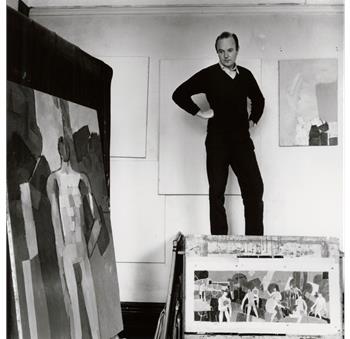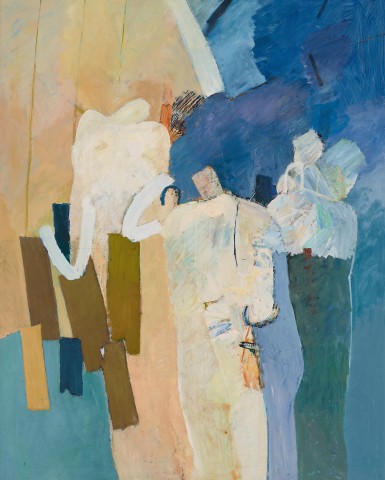BAPTISM, 1963
KEITH VAUGHAN
oil on canvas
127.0 x 101.5 cm
signed, dated and inscribed with title verso: BAPTISM / 1963 / Keith Vaughan (inverted)
inscribed on stretcher bar verso: commenced Jan 10/ 63 G B VAUGHAN (inverted)
label attached to frame verso: James Bourlet & Sons, Ltd London
Marlborough Galleries, London (label attached verso, dated 1964, stock no. LOLKV23)
Robert Shaw, Sydney
Thence by descent
Private collection, Sydney
Keith Vaughan, Marlborough New London Gallery, London, October 1964, cat.4
Cartwright Hall Art Gallery, City of Bradford Art Gallery, England, 1967 (label attached verso)
Premio Gaetano Marzotto per la Piuttura: La pittura figurativa in Europa (Gaetano Marzotto Prize for Painting: Figurative painting in Europe), Valdagno Gallery, Italy, 1968, cat.133
Hepworth A. & Massey I., Keith Vaughan: The Mature Oils 1946-1977, Sansom & Co., Bristol, United Kingdom, 2012, cat. AH421, p. 150
Bather: August 4th, 1961, 1961, oil on canvas, 102.2 x 91.4 cm, in the collection of the Tate Gallery, London, United Kingdom
Standing figure – blue background, 1963, oil on canvas, 122 x 91.5 cm, Private collection
Red landscape with figures, 1964, oil on canvas, 122 x 91.5 cm, in the collection of the Aberdeen Art Gallery, United Kingdom
dh200644_Keith Vaughan in his studio, Hampstead, London, 1960 resized.jpg

Keith Vaughan is associated with the second-wave of Britain’s Neo-Romantic artists, a generation forever affected by the horrors of World War Two. Like the movement’s original pre-War members – Paul Nash, Henry Moore and Graham Sutherland – these younger artists sought to create a truly British art, one which found its inspiration in the nation’s environment, history and literature, rather than creating a regional variant of overseas modernism. Key antecedents for the Neo-Romantics included the distinctively individual landscapes of Samuel Palmer and the visionary William Blake; and whilst some of Vaughan’s peers, including Francis Bacon and Lucian Freud, pursued a bleaker, nihilist view of humanity, he was more optimistic and lyrical. The canvases from the 1960s are considered to be among Vaughan’s finest, and Baptism, 1963, is a significant example that has not been seen publicly for over fifty years.
The major concern for the artist through his four decades of painting was how to reconcile the polarities of realism and abstraction when depicting figures in a landscape. Essentially self-taught, he spent much of the 1930s as a layout artist for the Unilever advertising company Lintas (the Australian painter John Passmore was a co-worker). In response to such training, Vaughan relied on photographs and preliminary drawings for his paintings until the 1950s when he abandoned the practice to work directly from life, a strategy which resulted in freer lines and painterliness within his images. Another key point was his exposure to a 1953 exhibition in London of work by Nicholas de Staël, an artist who utilised paint scrapers to create dramatic impasto paintings that walked the fine line between abstraction and reality. Five years later, Vaughan created his Lazarus paintings, his first series that successfully embraced these strategies. In 1959, he spent six months in the United States of America, teaching in the art department of Iowa State University, and then travelled along the Mississippi River, sketching the scenery and towns. Vaughan considered this to be a pivotal period, and the powerful paintings from the early years of the 1960s were the result.
The scholar Gerard Hastings points out that in spite of the religious theme of Baptism, Vaughan was an avowed atheist. However, this did not stop him referring to biblical and classical mythologies, and other works from the period allude to St Sebastian, the Laocoön and the deposition of Christ from the Cross. Hastings notes that Baptism is partially inspired by the Piero della Francesca painting of the same title in London’s National Gallery; in particular ‘a figure in the background at the right removing his shirt seemed to occupy Vaughan’s centre of interest. The frozen moment, the revelation of the male form, the awkwardness of the pose.’1 Vaughan reduces this figure to a flurry of marks whose unexpected agitation contrasts with the static, even sombre presentation of the central figures of Jesus and St John the Baptist. This accords with the artist’s stated aim that he wanted to maintain an ‘enigmatic poise’ between his figures, with an associated ambiguity about individual identities. After its exhibition in Italy in 1968, Baptism became part of the collection of Robert Shaw, an Australian businessman who had already shown his significant support for local art by sponsoring John Olsen’s journey through Spain in the 1950s.
The author gratefully acknowledges the assistance of Vaughan scholar Gerard Hastings in cataloguing this work.
1. See Olsen, J., Drawn from Life, Duffy & Snellgrove, Sydney, 1997, p.11
ANDREW GAYNOR
